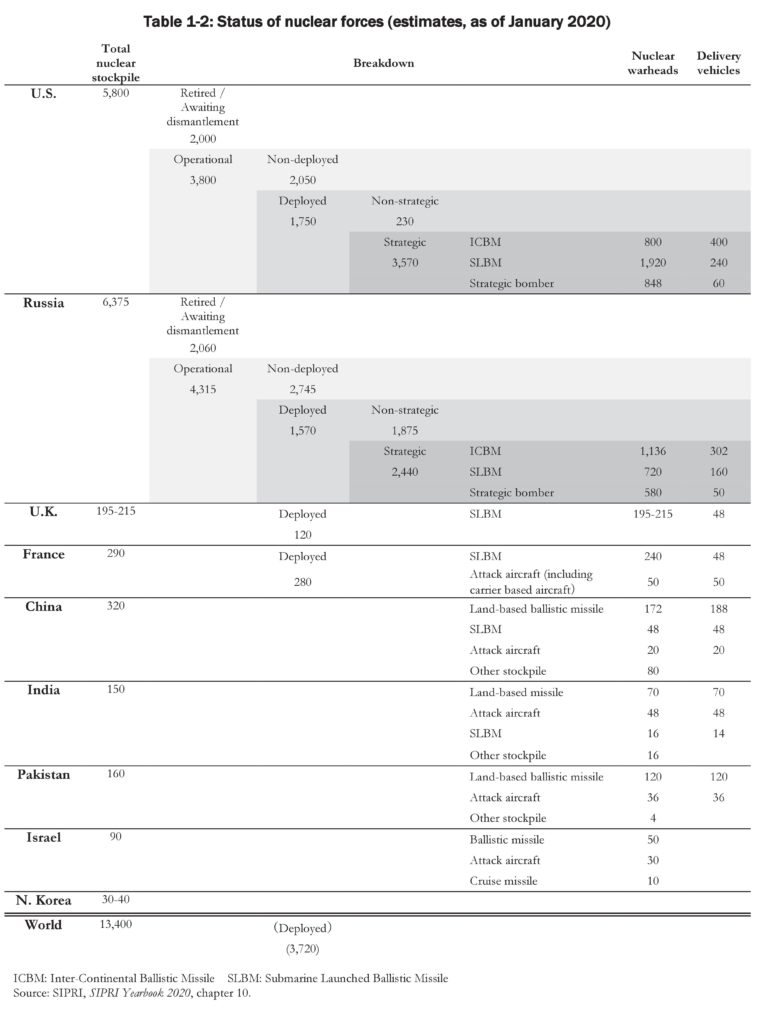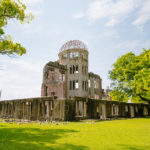Chapter 1 Nuclear Disarmament (1) Status of Nuclear Forces (estimates)
As of December 2020, eight countries have declared that they have nuclear weapons. According to Article IX-3 of the Nuclear Non-Proliferation Treaty (NPT), “a nuclear-weapon State is one which has manufactured and exploded a nuclear weapon or other nuclear explosive device prior to 1 January 1967.” China, France, Russia, the United Kingdom, and the United States meet this requirement, and have acceded to the NPT as nuclear-weapon states (NWS) as defined by the treaty. The three other countries that have tested nuclear weapons and declared having them are India, Pakistan and North Korea. India and Pakistan have never been parties to the NPT. Israel, a non-NPT state, has maintained a policy of “nuclear ambiguity” by neither confirming nor denying having nuclear weapons, although it is widely considered that it possesses them. (No conclusive evidence has emerged that Israel has conducted a nuclear explosive test.) In 2003, North Korea declared withdrawal from the NPT, and acquisition of nuclear weapons. In this report, these four additional states that have publicly declared possession of, or are believed to possess nuclear weapons are referred to as “other nuclear-armed states.”
The total number of nuclear weapons in the world, which grew to approximately 70,000 at the peak of the Cold War era, has been reduced significantly since the late 1980s. According to the estimates by the Stockholm International Peace Research Institute (SIPRI), however, 13,400 nuclear weapons still exist on the Earth, with the U.S. and Russian nuclear stockpiles together constituting more than 90 percent of the total.2 Compared to the approximately 9,200 nuclear weapons that were eliminated between 2010 and 2020, the 465 nuclear weapons eliminated between 2019 and 2020 indicates that the pace of reduction has been slowing. In addition, it is widely estimated that China, India, Pakistan and North Korea have each added about 10 warheads annually over the past several years (see Tables 1-1 and 1-2). Furthermore, as noted in section 4 (C) of this chapter, all of the nuclear-armed states have been actively pursuing the modernization of their nuclear forces.
Among nuclear-armed states, France declared it possesses not more than 300 nuclear weapons,3 and the United Kingdom announced plans to reduce its total nuclear stockpiles to not more than 180 by the mid-2020s. Other countries have not declassified the exact number of nuclear weapons in their arsenal.4
As for the number of nuclear weapons possessed by China, SIPRI estimates it as 320 as of January 2020, while the U.S. Department of Defense’s annual report titled Military and Security Developments Involving the People’s Republic of China estimated it to be in the low-200s.5 Experts from the U.S. think tank Federation of American Scientists (FAS) assess that “the Pentagon’s estimate only refers to ‘operational’ Chinese nuclear warheads, and therefore presumably excludes warheads that are attributed to newer weapons still in development. It is also possible that the Pentagon’s estimate does not include dormant bomber weapons.” In December 2020, they estimated that China has produced approximately 350 nuclear warheads.6
Meanwhile, the U.S. Department of Defense decided not to disclose the information regarding its current number of nuclear weapons in 2018, as requested by the FAS in 2019.7 The FAS asked the Department of Defense to disclose the size of U.S. nuclear weapons stockpile and the number of dismantled warheads in 2020, but was denied again. According to the FAS, the Defense Department in its denial letter “gave no reason for the denial other than stating that ‘the information requested cannot be declassified at this time.’”8


1 This chapter is authored by Hirofumi Tosaki.
2 Stockholm International Peace Research Institute, SIPRI Yearbook 2020: Armaments, Disarmament and International Security (Oxford: Oxford University Press, 2020), chapter 10.
3 In addition, France reports that “[i]t has no undeployed weapons. All of its weapons are deployed and operational.” NPT/CONF.2015/10, March 12, 2015.
4 On this point, Bruno Tertrais explains the reasons as following: “Stockpiles include weapons which are not entirely functional (when exactly does an atomic device become a ‘nuclear weapon’?), or which are used for nondestructive testing. As a result, giving an exact number can be difficult, misleading, and/or be accurate just for a given day.” Bruno Tertrais, “Comments on Hiroshima Report of March 2013,” Hiroshima Report Blog: Nuclear Disarmament, Nonproliferation and Nuclear Security, October 29, 2013, http://hiroshimareport.blogspot.jp/2013/10/op-ed-bruno-tertrais-comments-on.html.
5 U.S. Department of Defense, Military and Security Developments Involving the People’s Republic of China 2020, August 2020, p. 85.
6 Hans M. Kristensen and Matt Korda, “Nuclear Notebook: Chinese Nuclear Forces, 2020,” Bulletin of the Atomic Scientists, December 7, 2020, https://thebulletin.org/premium/2020-12/nuclear-notebook-chinese-nuclear-forces-2020/.
7 Hans M. Kristensen, “Pentagon Slams Door on Nuclear Weapons Stockpile Transparency,” Federation of American Scientists, April 17, 2019, https://fas.org/blogs/security/2019/04/stockpilenumbersecret/.
8 Hans Kristensen, “Trump Administration Again Refuses to Disclose Nuclear Weapons Stockpile Size,” Federation of American Scientists, December 3, 2020, https://fas.org/blogs/security/2020/12/nuclearstockpile-denial-2020/.






